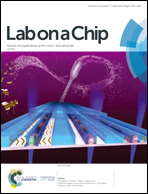Grooved step emulsification systems optimize the throughput of passive generation of monodisperse emulsions†
Abstract
Microfluidic step emulsification passively produces highly monodisperse droplets and can be easily parallelized for high throughput emulsion production. The two main techniques used for step emulsification are: i) edge-based droplet generation (EDGE), where droplets are formed in a single, very wide and shallow nozzle, and ii) microchannel emulsification (MCE), where droplets are formed in many separated narrow nozzles. These techniques differ in modes of droplet formation that influence the throughput and monodispersity of produced emulsions. Here we report a systematic study of novel grooved step emulsifying geometries, a hybrid of MCE and EDGE architectures. We introduce partitions of different heights to a wide (EDGE-like) slit to establish optimal geometries for high-throughput droplet production. We demonstrate that the volume and monodispersity of the produced emulsion can be tuned solely by changing the height of these partitions. We show that the spacing of the partitions influences the size of the produced droplets, but not the population monodispersity. We also determine the moment of transition between two distinct droplet generation modes as a function of the geometrical parameters of the nozzle. The optimized grooved geometry appears to combine the advantages of both MCE and EDGE, i.e. spatial localization of droplet forming units (DFUs), high-throughput formation of tightly monodisperse droplets from parallel DFUs, and low sensitivity to variation in the flow rate of the dispersed phase. As a proof-of-concept we show grooved devices that for a 260-fold increase of flow rate produce droplets with volume increased by just 75%, as compared to 91% increase in volume over a 180-fold increase of flow rate of the dispersed phase in MCE devices. We also present the optimum microfluidic device geometry that almost doubles the throughput of an MCE device in the generation of nanoliter droplets.

- This article is part of the themed collection: Lab on a Chip Recent Open Access Articles


 Please wait while we load your content...
Please wait while we load your content...